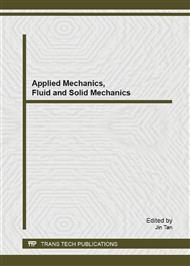[1]
H. M. Akil, M. F. Omar, A. A. M. Mazuki, S. Safiee, Z. A. M. Ishak, and A. Abu Bakar, Kenaf fiber reinforced composites: A review, Materials Design, vol. 32, no. 8–9, p.4107–4121, (2011).
DOI: 10.1016/j.matdes.2011.04.008
Google Scholar
[2]
S. Taj and M. A. Munawar, NATURAL FIBER-REINFORCED POLYMER COMPOSITES, vol. 44, no. 2, p.129–144, (2007).
Google Scholar
[3]
N. W. Abdul Razak and A. Kalam, Effect of Fibre Size on the Tensile Properties of Oil Palm Empty Fruit Bunch Fibre Composites, Advanced Materials Research, vol. 576, p.280–283, Oct. (2012).
DOI: 10.4028/www.scientific.net/amr.576.280
Google Scholar
[4]
P. Wambua, J. Ivens, and I. Verpoest, Natural fibres: can they replace glass in fibre reinforced plastics?, Composites Science and Technology, vol. 63, no. 9, p.1259–1264, Jul. (2003).
DOI: 10.1016/s0266-3538(03)00096-4
Google Scholar
[5]
J. Gassan, A study of fibre and interface parameters affecting the fatigue behaviour of natural fibre composites, Composites Part A Applied Science and Manufacturing, vol. 33, no. 3, p.369–374, (2002).
DOI: 10.1016/s1359-835x(01)00116-6
Google Scholar
[6]
B. N. DASH, A. K. RANA, H. K. MISHRA, S. K. NAYAK, S. C. MISHRA, and S. S. TRIPATHY, Novel, low-cost jute-polyester composites. Part 1 : Processing, mechanical properties, and SEM analysis, Polymer composites, vol. 20, no. 1, p.62–71.
DOI: 10.1002/pc.10335
Google Scholar
[7]
P. V Joseph, K. Joseph, and S. Thomas, E € ect of processing variables on the mechanical properties of sisal- ® ber-reinforced polypropylene composites, vol. 59, p.1625–1640, (1999).
DOI: 10.1016/s0266-3538(99)00024-x
Google Scholar
[8]
W. Gu, H. . Wu, S. . Kampe, and G. -Q. Lu, Volume fraction effects on interfacial adhesion strength of glass-fiber-reinforced polymer composites, Materials Science and Engineering: A, vol. 277, no. 1–2, p.237–243, Jan. (2000).
DOI: 10.1016/s0921-5093(99)00528-6
Google Scholar
[9]
C. A. S. Hill and N. S. Cetin, Surface activation of wood for graft polymerisation, vol. 20, no. March 1999, p.71–76, (2000).
Google Scholar
[10]
J. L. Thomason, The influence of fibre length, diameter and concentration on the modulus of glass fibre reinforced Polyamide 6, 6, Composites Part A Applied Science and Manufacturing, vol. 39, no. 11, p.1732–1738, (2008).
DOI: 10.1016/j.compositesa.2008.08.001
Google Scholar
[11]
H. Ku, H. Wang, N. Pattarachaiyakoop, and M. Trada, A review on the tensile properties of natural fiber reinforced polymer composites, Composites Part B: Engineering, vol. 42, no. 4, p.856–873, Jun. (2011).
DOI: 10.1016/j.compositesb.2011.01.010
Google Scholar
[12]
A. Ashori, Hybrid Composites from Waste Materials, Journal of Polymers and the Environment, vol. 18, no. 1, p.65–70, Dec. (2009).
Google Scholar
[13]
R. Agrawal, N. . Saxena, K. . Sharma, S. Thomas, and M. . Sreekala, Activation energy and crystallization kinetics of untreated and treated oil palm fibre reinforced phenol formaldehyde composites, Materials Science and Engineering: A, vol. 277, no. 1–2, p.77–82, Jan. (2000).
DOI: 10.1016/s0921-5093(99)00556-0
Google Scholar


